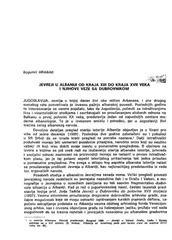Приказ основних података о документу
Jevreji u Albaniji od kraja XIII do kraja XVII veka i njihove veze sa Dubrovnikom
The Jews in Albania from the end of the 13th century to the end of the 17th century and their relations to Dubrovnik
| dc.creator | Hrabak, Bogumil | |
| dc.date.accessioned | 2019-11-22T14:02:21Z | |
| dc.date.available | 2019-11-22T14:02:21Z | |
| dc.date.issued | 1971 | |
| dc.identifier.issn | 0353-0612 | |
| dc.identifier.uri | https://www.jevrejskadigitalnabiblioteka.rs/handle/123456789/83 | |
| dc.description.abstract | Posebnih studija o albanskim Jevrejima zasada nema. Veliki pregledi povesti jevrejskog naroda zaobilazili su jevrejske naseobine čak i u Draču J Valoni, a monografije o Jevrejima u susednim zemljama su tek sasvim fragmentarno dodirivale situaciju u Albaniji. Kad je reč o jugoslovenskoj nauci, častan izuzetak predstavlja knjiga prof. Jorja Tadića Jevreji u Dubrovniku do polovine XVII stoljeća (1937).Veoma intenzivno proučavanje dragocene dubrovačke arhivske građe, značajne mogućnosti koje se mogu ostvariti ispitivanjem turskih popisnih deftera, započeto sakupljanje podataka za Albaniju veoma obilnog arhivskog fonda Venecijanskog arhiva, kao i izvesna objavljena građa na hebrejskom jeziku, pružaju već sada mogućnosti da se trasira razvitak i jevrejskih naseobina po albanskim gradovima i da se naučno fiksiraju činjenice, naročito kad je reč o poslovnoj strani života albanskih Jevreja. Na albanskoj povesti Skenderbegova perioda mnogo se radi, te su i neke zbirke dokumenata objavljene (J. Radonić. 1942; Ferenz Pal 1965, iz arhiva Sforca), no tu nema vesti o Jevrejima, uostalom kao ni u velikoj i impresivnoj biografiji Skenderbega iz pera skadarskog renesansnog istoričara Barletija. | sr |
| dc.description.abstract | There are no studies dealing with the Albanian Jews, though there are more archival data on them than on the Jews in other Balkan countries. The author of the present paper has thoroughly examined the funds of the Archives in Dubrovnik and consulted the published Jewish, Turkish and Venetian materials, applying to a certain extent the comparative method to the drawing of conclusions on certain phenomena. The paper comprises only partly the activity of the Jews of Dubrovnik in Albania. Although the Jews came very early to the Albanian towns (Durazzo and Valona), in all probability at the same time as in the neighbouring Greek towns, the strict archival data concerning them exist only since 1281. The relations of the Jews of Durazzo with Dubrovnik have become more frequent from the middle e of the 14th century only when they usually sold salt to Dubrovnik and bought textiles there. After Durazzo had fallen under the sway of Venice (1392), the Jews in this town first were reduced to poverty and then simply disappeared. Already from the beginning of the 15th century, the Jewish colony in Valona assumed the importance of the leading Jewish colony in Albania. The 15th century was the period of stagnancy of the Jewry in Albania. At the end of that century there arrived, without any doubt, also to Valona the German Jews, driving back the “Romaniots", Jews speaking Greek, who lived there before their arrival and who were very well connected with Corfu and the Jewish oases in South Italy. In the first years of the 16th century there came to settle in Valona masses of Jews from the Pyrenean Peninsula. In the 16th century, Valona was preponderantly a Jewish town, for the Jews constituted more than a half of the population of Valona (which numbered, at that time, over 4,000 people), the most populated town of Albania in this period. Like in Saloniki, Rome and in other places, there arose in Valona, too, the conflicts between various groups of Jews. having come from different parts of the world. From the middle of the 16th century, the Jews immigrated from Italy, particularly from Ancona, lent the principal characters to the colony of Valona. Since 1520, the Jews of Valone began to make business, by sea via Dubrovnik, with Venice and particularly with Ancona. They imported textiles and other manufactured goods from the West. Since that time they began also to enter into arrangements to export wheat from the region of Valona to Dubrovnik and even to Venice. Like salt in former times, wheat, pitch and cordovan were the main articles on which the inhabitants of Valona founded their prosperity. Their rapid strengthening was very much aided by the fact that they acted as agents and intermediaries to their compatriots from Saloniki and other towns of Macedonia in their business transactions with Italy and Ancona. On this basis the Jews of Valona developed mighty exchange traffic, granting credits at 20% to 30% interest. In this way, they considerably increased the purchases of wheat to the merchants of Dubrovnik and Venice who were not always obliged to carry gold coins on themselves. The goods of Albanian Jews suffered considerable damages at sea by the pirates, in the first place by the uskoks. Among the Jews of Valona, there distinguished himself in the first decades of the 16th century Isaac Trink, who was also the first consul of Dubrovnik in Valona. After him, this office was taken by his nephew Angelo Samuel’s son who had some serious conflicts with two exporters of Dubrovnik. Towards the middle of the 16th century 'in addition to the old synagogue there existed also a new one. In the sixtieth of the 16th century, there was considerably increased the commercial importance of Alesio where a Jew of Skoplje was installed as the Jewish "consul”. Alesio became the port for the export of leather and wool of Skopje, Macedonian and Kosovo wheat, half-molten ore from the mining basin of Kosovo and of other goods. The importance of Alesio constantly increased, particularly on account of the traffic with Ancona. Since the end of the 16th century, the importance of Durazzo begins to increase, first as the port for the importation of textiles. Berat got a small Jewish colony in the course of the 16th century, but the greater merchants appeared in it at the end of the century only and they developed by the mass importation of silk (particularly Salomon Albala). ln Scutary there were but a few Individual Jews, physicians for instance. From the sixties on (and almost for a whole century) the consuls of Dubrovnik at Valona were supplied by a Jewish family immigrated from Ancona, named Koduto (Jacob, Daniel, Abraham and Abraham Jr.). The fundamental duties of these Jews-consuls of Dubrovnik at Valona were: assistance in purchasing cereals; redemption of slaves. The salves were redeemed also by many other Jews, some of whom made a business of it. The real ascent of Jews in Valona and in Alesio (in addition to Berat and Durazzo) should be dated at the period following the Cyprus war (1570—1573). In Valona or in connection with Valona there existed a dozen of ramified powerful merchant families (Catinella, Trink, Graziano, Arah, Jahja, Hazan, Benvenisti, Maca, afterwards also Cabillo), some of them had their embranchments also in Kastoria, Berat, Alesio, Venice and Ancona. In addition to the above enumerated, there existed also some dozens of other powerful merchants — exporters. Valona exerted a very great attraction upon the Italian Jews and therefore there were constantly occurring immigrations (e.g. in 1591). The main export products of Albanian Jews were: cordovan and other kinds of leather (Valona and Alesio), wheat and sorghum (Valona and Alesio), biscuits (Vaiona), silk (Berat), pitch and wine (Valona), semi-manufactured wood, oak-galls (“valonea”, Valona), enamel ore (Alesio): the importations comprised charysea, satin and other woolen textiles and silks, lamb furs, glassware, etc. Financial affairs (drafts, loans) were connected to export transactions and had no connection to petty consumer’s credits and local usury. Up to the thirties of the 16th century, the Jews of Saloniki sent their transports via Valona. Valona was, in the course of the 17th century, developing a greater business activity than, for instance, Skoplje. Several documents of Jewish and other origins illustrate some aspects of the personal and family life of the Jews of Valona, particularly in the 17th century. The Jews of Valona and of Alesio could not be exterminated by very frequently occurring and violent epidemics no could their business activity be seriously menaced by the piracy and the robberies on the roads of Albania and of Macedonia, but they were ruined by the events of the war. During the Turkish-Venetian war in 1688, the Jews of Velona were obliged to leave their native town and to move to Berat; however, when the plague broke out in this latter town (1691), they scattered in all directions. A part of immigrants from Valona left Berat after 1740 and settled at Janina, Bltolj and Kastoria. There are no data available concerning the destiny of Jews In Alesio and in Durazzo from the 17th century on. | en |
| dc.language.iso | sr | sr |
| dc.publisher | Beograd : Savez jevrejskih opština Jugoslavije [Federation of Jewish Communitues in Jugoslavia] | sr |
| dc.rights | openAccess | sr |
| dc.rights.uri | https://creativecommons.org/licenses/by-nc-nd/4.0/ | |
| dc.source | Zbornik 1 : Studije i građa o Jevrejima Dubrovnika, Jevrejski istorijski muzej - Beograd = Jewish studies 1 : Studies and documents about Jews in Dubrovnik, Jewish historical museum - Belgrade | sr |
| dc.subject | Jevreji Dubrovnika | sr |
| dc.subject | Jevreji Albanije | sr |
| dc.subject | Jews of Dubrovnik | sr |
| dc.subject | Jews of Albania | sr |
| dc.subject | Isaac Trink | sr |
| dc.subject | Catinella, porodica | sr |
| dc.subject | Trink, porodica | sr |
| dc.subject | Graziano, porodica | sr |
| dc.subject | Arah, porodica | sr |
| dc.subject | Jahja, porodica | sr |
| dc.subject | Hazan | sr |
| dc.subject | Benvenisti | sr |
| dc.subject | Maca, porodica | sr |
| dc.subject | Cabillo, porodica | sr |
| dc.subject | Kaduto, porodica | sr |
| dc.title | Jevreji u Albaniji od kraja XIII do kraja XVII veka i njihove veze sa Dubrovnikom | sr |
| dc.title | The Jews in Albania from the end of the 13th century to the end of the 17th century and their relations to Dubrovnik | en |
| dc.type | article | sr |
| dc.rights.license | BY-NC-ND | sr |
| dcterms.abstract | Храбак, Богумил; | |
| dcterms.abstract | Храбак, Богумил; | |
| dc.rights.holder | Savez jevrejskih opština Srbije = Federation of Jewish Communities of Serbia | sr |
| dc.identifier.fulltext | http://jevrejskadigitalnabiblioteka.rs/bitstream/id/112/JIM0105BOGUMILHRABAKJEVREJIUALBANIJI.pdf | |
| dc.type.version | publishedVersion | sr |
| dc.citation.spage | 55 | |
| dc.citation.epage | 97 | |
| dc.citation.issue | 1 | |
| dc.identifier.rcub | https://hdl.handle.net/21.15107/rcub_jdb_83 |
Документи
Овај документ се појављује у следећим колекцијама
-
Gradovi i mesta - istorija [Cities and Places - history]
-
Zbornik JIM 01 [Jewish Studies JHM 01]
Studije i građa o Jevrejima Dubrovnika / Studies and Documents about Jews in Dubrovnik

